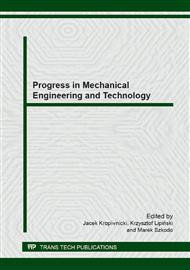[1]
Achkasov A. N., Grechko G. I. V. A. Shishkin Nuclear Propulsion Systems, Atomic Energy, Vol. 103, No. 1, (2007).
DOI: 10.1007/s10512-007-0084-1
Google Scholar
[2]
Angenendt H., Hauschildt P., Teppner R. Conventional Submarines' Propulsion Systems for Endurance and Dash Speed, Military Technology, MILTECH, 3/(2007).
Google Scholar
[3]
Boehm C., Starflinger J., Schulenberg T., Oeynhausen H. Supercritical Steam Cycle for Lead Cooled Nuclear Systems, Proceedings of GLOBAL 2005, Japan, Paper No. 035, (2005).
Google Scholar
[4]
Danielyan D. Supercritical-Water-Cooled Reactor System - as one of the most promising type of Generation IV Nuclear Reactor Systems, Generation-IV Roadmap Report, (2003).
Google Scholar
[5]
Hammerschmidt A. E. Fuel Cell Propulsion of Submarines, Paper to be presented at: Advanced Naval Propulsion Symposium, October 30-31, 2006, Arlington, VA, USA, (2006).
Google Scholar
[6]
Internet page: http: /americanhistory. si. edu/Subs/ operating/propulsion/reactor/index. html.
Google Scholar
[7]
Jane F.T. Jane's Fighting Ships 2004-2005, Edited by Commodore Stephen Saunders RN, ISBN 0710626231, (2004).
Google Scholar
[8]
Kłos R. Removal of oxidable contaminations contained in submarine atmosphere, POLISH MARITIME RESEARCH, No 3(57), Vol. 15, (2008).
DOI: 10.2478/v10012-007-0085-y
Google Scholar
[9]
Kosowski K. Introduction to the Theory of Marine Turbines, Wydawnictwo Politechniki Gdańskiej, Gdansk, (2005).
Google Scholar
[10]
Neves G. L. C. Air-Independent Propulsion (AIP): Increasing the Threat of the Conventional Submarine, PASSADIÇO, CAAML, (2007).
Google Scholar
[11]
Ragheb M. Nuclear Marine Propulsion, Nuclear Power Engineering, NPRE 402/ME 405, University of Illinois at Urbana-Champaign, Nuclear, Plasma and Radiological Engineering, (2009).
DOI: 10.26634/jfet.5.1.1022
Google Scholar
[12]
Schank J. F. et al. Sustaining U.S. Nuclear Submarine Design Capabilities, ISBN 978-0-8330-4160-9, Copyright 2007 RAND Corporation (2007).
Google Scholar
[13]
Tall J. Submarines and deep-sea vehicles, Copyright 2002 by Amber Books Ltd. London, ISBN 5 -699-05680-7, (2002).
Google Scholar
[14]
Tulkki V. Supercritical Water Reactors, A Survey on International State of Research in 2006" Master, s thesis, HELSINKI UNIVERSITY OF TECHNOLOGY, Department of Engineering, Physics and Mathematics, Otaniemi, November 6, (2006).
Google Scholar
[15]
Wagner W., ·Kretzschmar H. -J. International Steam Tables Properties of Water and Steam Based on the Industrial Formulation IAPWS-IF97 Tables, Algorithms, Diagrams, and CD-ROM Electronic Steam Tables, Springer-Verlag, Berlin, Heidelberg, (2008).
DOI: 10.1007/978-3-540-74234-0_7
Google Scholar


